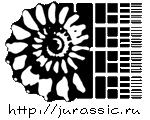Есть один редкий журнал (живьем я, по-моему, видел один его выпуск лишь однажды) Acta Palaeontologica Romaniae - который недавно стал доступен и в электрическом виде в нем публикуются самые разные палеонтологические работы, по отложениям самого разного возраста и различным группам организмов - и в общем это что-то вроде Ежегодника ВПО, но румынского
Среди публикаций попадается немало юрских - например, в последних двух выпусках - вот такие работы:
1) Ţibuleac P. (2008) Presence of big size ammonites in the Jurassic olistoliths of Transylvanian Nappe(s) from Rarau Syncline (Eastern Carpathians, Romania) // Acta Palaeontologica Romaniae. V.6. P.365-374.
pdf: http://www.geo-paleontologica.org/Acta.vol.VI/Tibuleac.pdf
Rarău Syncline is known through various ammonite faunas, from Triassic to Early Cretaceous, but only two specimen of large ammonites were quoted until now, respectively from Sinemurian (Bodia Hill) and Aalenian (Moldova slope). The paper added a new fossiliferous point with big size ammonites (Praşca Peak, Sinemurian: Zetoceras bonarelli, Coroniceras (Coroniceras) cf. lyra, C. (Paracoroniceras) sp. etc) and remembered the first two records.
2) Callomon J.H., Gradinaru E. (2005) From the thesaurus of the museum collections. I. Liassic ammonites from Munteana (Svinita Zone, Southern Carpathians, Romania) // Acta Palaeontologica Romaniae. V.5. P.49-65.
pdf: http://www.geo-paleontologica.org/Acta.vo....pdf.pdf
The taxonomy of the Liassic ammonites from Munteana (Sviniţa Zone, South Carpathians, Romania) collected by Răileanu (1953), with some subsequent additions, preserved in the collections of the Department of Geology in the Faculty of Geology and Geophysics, University of Bucharest, is reviewed. The most important elements are represented by the Liparoceratidae. These include forms hitherto unknown, described now as Liparoceras carpathicum sp.nov. [M] and Aegoceras carpathicum sp.nov. [m]. These liparoceratids reveal the presence of a sharply-constrained biohorizon in the Liassic deposits of Munteana of Pliensbachian, Late Carixian age (Davoei Zone) and provide an important palaeobiogeographic reference-point in the region of the Carpathians. The Liassic ammonite fauna from Munteana in Răileanu's collection illustrates the value of the fossils that are locked in museum collections, waiting to be described.
3) Tchoumachenko P., Yaneva M., Uchman A., Tronkov D., Trifonova E., Petrunova L. (2005) Ichno- and body-fossils from the Upper Triassic-Lower Jurassic Sinivir Formation in the Balaban Dere Valley (East Stara Planina Mts., East Bulgaria) and the problem of the Triassic/Jurassic boundary // Acta Palaeontologica Romaniae. V.5. P.463-475
pdf: http://www.geo-paleontologica.org/Acta.vo....pdf.pdf
The Triassic and Jurassic sediments in East Stara Planina Mts. are of two types: (a) parautochtonous - relatively deep marine sediments, Tethyan type, and (b) allochtonous - shallow marine deposits, Peri-Tethyan type (included in the first as olistolites). The parautochtonous type had been sedimented in unilateral rift-basin, and the allochtonous type - on the shelf, connecting the basin with the dry land to the South. The Glogova Fm. (Upper Carnian (p. p.) - Norian (p. p.), and Sinivir Fm. (Norian (p. p.) - Toarcian (p. p.) are studied here. They are related to a progressive transition and contain deep-water ichnofossils – Nereites ichnofacies. Middle Norian bivalves – Monotis salinaria salinaria, and Monotis cf. salinaria haueri are collected in the lower parts of Sinivir Fm., and higher - fragments of Jurassic belemnites. In a nearby section spores and pollens of Late Pliensbachian Ischyosporites variegates/Matonisporites crassiangulatus Biointerval Zone, dinocystes as Nannoceratopsis gracilis (Pliensbachian - Middle Bathonian), which indicate Spheripollenites subgranulatus Acme-Zone, as well as Liassic foraminifers Ammodiscus infimus, Annulina metensis, etc. are collected. The boundary Triassic/Jurassic, in deep water conditions, is located in Sinivir Fm. and is connected with progressive transition, whilst in shelf conditions the boundary is related to a break in the sedimentation.
4) Lazăr I. (2005) The Jurassic Bivalve fauna from the western side of the Bucegi Mountains. Part II. Subclass Pteriomorphia (Order Pectinoida) // Acta Palaeontologica Romaniae. V.5. P.277-294.
pdf: http://www.geo-paleontologica.org/Acta.vol.V/Lazar_pdf.pdf
Eleven taxa, from the bivalve subclass Pteriomorphia (Order Pectinoida) were recorded from the rich faunal assemblages of the Middle Jurassic (Bajocian - Bathonian) deposits that outcrop in the western side of Bucegi Mountains (South Carpathians). All of these species are described and figured for the first time for the studied area and many of them represent the first record of the respective taxa in the Bucegi Mountains. The bivalves occur in rocks ranging from calcareous sandstones and argillaceous silts to biocalcarenites. Stratigraphic occurrence and facies affinities are also recorded for the studied taxa.
 Форум Jurassic.ru
Форум Jurassic.ru

 Форум Jurassic.ru
Форум Jurassic.ru

